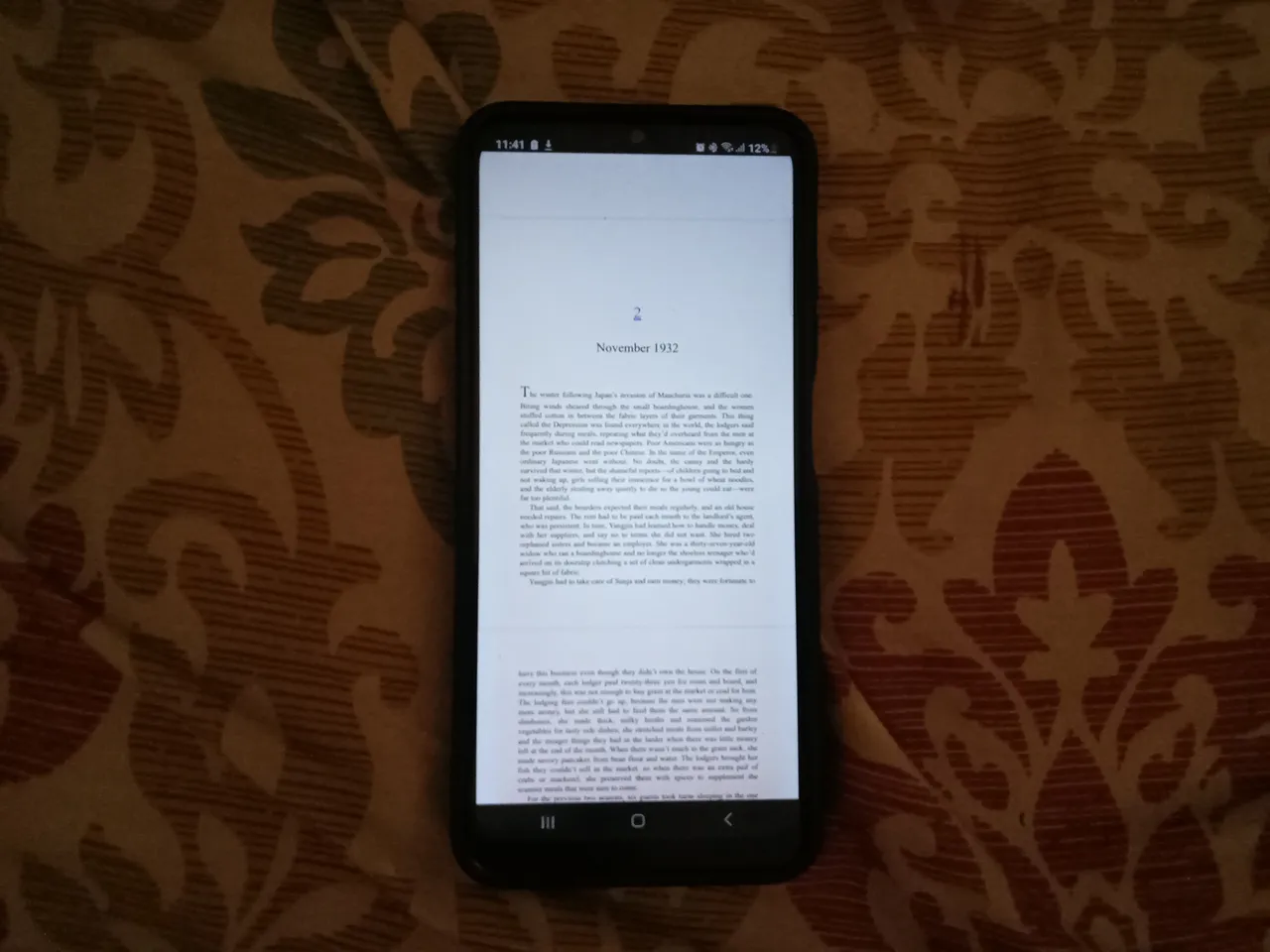
When I was tutoring a Korean student, one thing that really took me aback was how, from a young age, they were taught about the Japanese discrimination toward them. At the time, I didn’t know much about South Korea or anything about the peninsula. I thought the eastern side of Asia was pretty much all cool and dandy but that wasn’t all true.
𝘙𝘦𝘤𝘦𝘯𝘵𝘭𝘺, 𝘰𝘷𝘦𝘳 𝘏𝘪𝘷𝘦 𝘉𝘰𝘰𝘬 𝘊𝘭𝘶𝘣 𝘵𝘩𝘦𝘳𝘦'𝘴 𝘢 𝘸𝘦𝘦𝘬𝘭𝘺 𝘔𝘰𝘯𝘥𝘢𝘺 𝘱𝘳𝘰𝘮𝘱𝘵 𝘢𝘯𝘥 𝘵𝘩𝘪𝘴 𝘸𝘦𝘦𝘬 𝘪𝘴 "What book introduced you to a culture different from your own, and what did you learn about that culture?". 𝘍𝘰𝘳 𝘮𝘰𝘳𝘦 𝘰𝘧 𝘵𝘩𝘦 𝘱𝘳𝘰𝘮𝘱𝘵 𝘴𝘦𝘦 𝘩𝘦𝘳𝘦 : 𝘏𝘪𝘷𝘦 𝘉𝘰𝘰𝘬 𝘊𝘭𝘶𝘣 𝘏𝘪𝘨𝘩𝘭𝘪𝘨𝘩𝘵 #318

My student got me into exploring the horrors of East Asia, the story that we’re not so much exposed to. Long story short, I learned that much like Indonesian, they were colonized by the Japanese. They suffered longer than Indonesian with 35 years under the iron hand of Japanese colonial rule. For us, the Japanese colonization for 3,5 years already left us with horrors and trauma. We learned at school that their rule was much harder than how the Dutch were portrayed. Apparently, in South Korea, it wasn’t that far from being similar and that was even longer. The Japanese were as ruthless as they were in other parts of the world. That era in South Korea also becomes an intriguing historical exploration as it contains so many stories of tensions between Korea and Japan. I got to know Pachinko just a few years after it was initially released. I never really explored it until the series came and I got interested in it more.

As seen in Pachinko written by Min Jin Lee and published back in 2017, we’re taken to relive the lives of Korean families under the reign of Japan. It starts with a story of a couple Yangjin and Hoonie, from a fishing village who own a house and rent the rooms for extra income. The family tried to have children but none of them survived until Sunja, their healthy beautiful daughter came into the picture. Their happiness was short-lived because Hoonie, the husband, died and Yangjin had to raise Sunja.


When Sunja was 16 years old, she met a wealthy Korean man named Koh Hansu. He was a broker for the fisherman in the village although he was mostly living in Japan. This is the turning point of Sunja’s life where she got pregnant but later finding out that Hansu was a married man and couldn’t marry Sunja legally. This is where the story starts to get interesting as Sunja is married to a North Korean Christian minister who happens to be traveling and stops by Sunja’s lodging called Baek Isak. Isak stopped by as he was recommended by his older brother Yoseb to visit the lodging before eventually boarding to Osaka, to work for a church there. Unfortunately, he was ill during his stay at the lodging and was taken care of by Yangjin and Sunja. When he heard Sunja was pregnant, as a request from her mother Yangjin, Isak was willing to marry Sunja since the family saved his life.
At this time, Hansu was out of the picture yet he was always around in Sunja’s life. He constantly watches over Sunja and he knows that she is pregnant with his child. Long story short, Sunja moved to Japan and witnessed even more discrimination that the south korean faced in Japan. They lived in a ghetto area where only Koreans lived. Sunja eventually gave birth to Noa and Mozasu. Noa’s biological father is Hansu while Mozasu’s was Sunja’s son with Baek Isak.

Sunja’s son faced discrimination as they grew up among the Japanese and they tried to hide their Korean identity at first. In Japan, they are called Zainichi and these people have limited social mobility as well. They are known to particularly work in Pachinko, some type of game parlor that involves gambling(think of modern vegas establishments). The first person in Sunja’s family that works in Pachinko was Mozasu. The story goes on until the birth of Solomon Baek, Mozasu’s son who wanted to establish Pachinko but was dissuaded because of the stigma that comes with it.

Pachinko is a multi-generational story that discusses the lives of Koreans during that era. It talks about a woman's position in the society, the role of a husband, duality and identity problems that these characters faced. It gives a glimpse to cultural shifts that happened at the time and how these Zainichis survived through it all.

For an outsider like myself, I find it very intriguing that the North Koreans weren’t as poor as today. While it could have been a fiction, it was portrayed that before the divide, the north korean were landowners and during the japanese occupation, a lot of lands were seized or because of the heavily imposed tax, they couldn’t afford it anymore hence selling the land. At the same time, while today North Korea is known to be irreligious, it wasn’t the same back in the day. There were religions there and even Christianity was also there. As seen in the story, Baek’s family was christian and he even became a priest. However, in Japan during WWII, they tried to impose the religion where people praised the emperor and the protestant didn’t want to do that hence, just as reflected in the story, Baek Isak was detained as well.

I also learned that culturally in South Korea at the time, rice was only consumed during very important events. It was shown that only the Japanese could afford and the South Koreans who can afford it are the wealthier ones.
There's a series on it if you want to watch it rather than read the book. However, after having watched the series, the book made more sense. The pacing, the timing too was easier to digest than the film. The book also explained more than what was shown in the series. This book truly is a literary work that helps me understand other cultures better. It’s still astonishing to me that now South Korea has grown so much and is able to overcome their darkest past.
I would definitely recommend Pachinko if you fancy learning more about Korean’s culture and history. It gives a rare glimpse of things that we normally aren’t exposed to.


 | 𝘔𝘢𝘤 𝘪𝘴 𝘢 𝘴𝘦𝘭𝘧-𝘦𝘮𝘱𝘭𝘰𝘺𝘦𝘥 𝘯𝘪𝘯𝘫𝘢 & 𝘤𝘰𝘧𝘧𝘦𝘦 𝘤𝘰𝘯𝘯𝘰𝘪𝘴𝘴𝘦𝘶𝘳 . 𝘈 𝘵𝘺𝘱𝘪𝘤𝘢𝘭 𝘪𝘯𝘵𝘳𝘰𝘷𝘦𝘳𝘵 𝘪𝘯 𝘭𝘰𝘷𝘦 𝘸𝘪𝘵𝘩 𝘭𝘪𝘵𝘦𝘳𝘢𝘵𝘶𝘳𝘦, 𝘣𝘰𝘰𝘬𝘴, 𝘵𝘦𝘤𝘩𝘯𝘰𝘭𝘰𝘨𝘺 𝘢𝘯𝘥 𝘱𝘩𝘪𝘭𝘰𝘴𝘰𝘱𝘩𝘺. 𝘛𝘩𝘪𝘴 𝘪𝘴 𝘩𝘦𝘳 𝘱𝘦𝘳𝘴𝘰𝘯𝘢𝘭 𝘣𝘭𝘰𝘨, 𝘢 𝘳𝘦𝘧𝘭𝘦𝘤𝘵𝘪𝘰𝘯 𝘰𝘧 𝘩𝘦𝘳 𝘸𝘢𝘯𝘥𝘦𝘳𝘭𝘶𝘴𝘵 𝘢𝘯𝘥 𝘵𝘩𝘪𝘳𝘴𝘵 𝘧𝘰𝘳 𝘬𝘯𝘰𝘸𝘭𝘦𝘥𝘨𝘦. 𝘚𝘩𝘦 𝘰𝘧𝘵𝘦𝘯 𝘤𝘰𝘷𝘦𝘳𝘴 𝘣𝘰𝘰𝘬𝘴, 𝘮𝘰𝘷𝘪𝘦 𝘢𝘯𝘥 𝘴𝘦𝘳𝘪𝘦𝘴 𝘳𝘦𝘷𝘪𝘦𝘸𝘴, 𝘵𝘦𝘤𝘩 𝘳𝘦𝘷𝘪𝘦𝘸𝘴 𝘢𝘯𝘥 𝘵𝘳𝘦𝘯𝘥𝘴, 𝘱𝘩𝘰𝘵𝘰𝘨𝘳𝘢𝘱𝘩𝘺, 𝘢𝘯𝘥 𝘱𝘦𝘳𝘴𝘰𝘯𝘢𝘭 𝘥𝘦𝘷𝘦𝘭𝘰𝘱𝘮𝘦𝘯𝘵. 𝘖𝘯𝘤𝘦 𝘪𝘯 𝘢 𝘣𝘭𝘶𝘦 𝘮𝘰𝘰𝘯, 𝘺𝘰𝘶 𝘤𝘢𝘯 𝘧𝘪𝘯𝘥 𝘩𝘦𝘳 𝘵𝘳𝘢𝘷𝘦𝘭𝘪𝘯𝘨, 𝘪𝘮𝘮𝘦𝘳𝘴𝘪𝘯𝘨 𝘩𝘦𝘳𝘴𝘦𝘭𝘧 𝘪𝘯 𝘭𝘰𝘤𝘢𝘭 𝘤𝘶𝘭𝘵𝘶𝘳𝘦𝘴 𝘢𝘯𝘥 𝘵𝘳𝘢𝘥𝘪𝘵𝘪𝘰𝘯𝘴, 𝘢𝘯𝘥 𝘵𝘢𝘬𝘪𝘯𝘨 𝘱𝘪𝘤𝘵𝘶𝘳𝘦𝘴 𝘰𝘧 𝘵𝘩𝘦 𝘣𝘦𝘢𝘶𝘵𝘪𝘧𝘶𝘭 𝘴𝘪𝘨𝘩𝘵𝘴 𝘴𝘩𝘦 𝘦𝘯𝘤𝘰𝘶𝘯𝘵𝘦𝘳𝘴 𝘢𝘭𝘰𝘯𝘨 𝘵𝘩𝘦 𝘸𝘢𝘺. 𝘚𝘩𝘦'𝘴 𝘢𝘯 𝘰𝘤𝘤𝘢𝘴𝘪𝘰𝘯𝘢𝘭 𝘧𝘰𝘰𝘥𝘪𝘦 𝘢𝘯𝘥 𝘭𝘰𝘷𝘦𝘴 𝘵𝘰 𝘦𝘹𝘱𝘭𝘰𝘳𝘦 𝘯𝘦𝘸 𝘢𝘯𝘥 𝘥𝘦𝘭𝘪𝘤𝘪𝘰𝘶𝘴 𝘤𝘶𝘭𝘪𝘯𝘢𝘳𝘺 𝘦𝘹𝘱𝘦𝘳𝘪𝘦𝘯𝘤𝘦𝘴. 𝘍𝘰𝘭𝘭𝘰𝘸 𝘢𝘭𝘰𝘯𝘨 𝘰𝘯 𝘩𝘦𝘳 𝘢𝘥𝘷𝘦𝘯𝘵𝘶𝘳𝘦𝘴 𝘢𝘯𝘥 𝘫𝘰𝘪𝘯 𝘵𝘩𝘦 𝘤𝘰𝘯𝘷𝘦𝘳𝘴𝘢𝘵𝘪𝘰𝘯! 𝘋𝘰𝘯'𝘵 𝘩𝘦𝘴𝘪𝘵𝘢𝘵𝘦 𝘵𝘰 𝘶𝘱𝘷𝘰𝘵𝘦, 𝘭𝘦𝘢𝘷𝘦 𝘢 𝘤𝘰𝘮𝘮𝘦𝘯𝘵 𝘰𝘳 𝘢 𝘧𝘦𝘦𝘥𝘣𝘢𝘤𝘬. 𝘈 𝘳𝘦-𝘣𝘭𝘰𝘨 𝘪𝘴 𝘢𝘭𝘴𝘰 𝘢𝘱𝘱𝘳𝘦𝘤𝘪𝘢𝘵𝘦𝘥 𝘵𝘰𝘰. |
